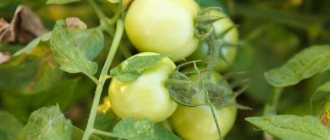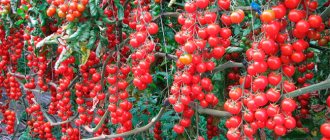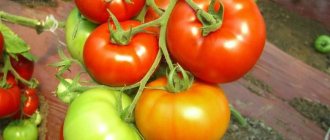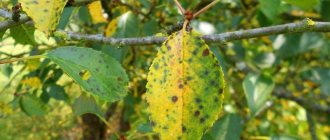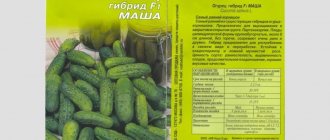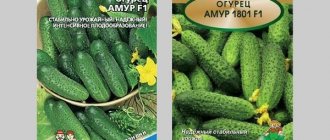Vegetable growing » Pepper
0
1292
Article rating
Kira Stoletova
When choosing a pepper variety, many gardeners give preference to the Morozko variety. Morozko pepper is characterized by cold resistance, early ripening, high yield and ease of care. A detailed description is presented in the article.
Morozko pepper variety
What kind of variety is this
The vegetable is an early ripening vegetable; gardeners harvest in just 110-115 days. For care, you do not need to have special techniques and rules - Morozko pepper is not picky and produces a harvest even with minimal adherence to the rules of watering and fertilizing.
Distinctive features
Morozko differs from other varieties in its elongated shape and perfectly smooth surface. The variety is intended for cultivation in the West Siberian region. The vegetable is resistant to diseases and insect pests, and is perfectly stored and transported.
Fruit characteristics and yield
Cone-shaped fruits at the stage of technical ripeness acquire a green color, after which they become bright red. The weight of one vegetable is about 100 g, the wall thickness is about 0.7 mm. The taste is pleasant, sweet. From 1 sq. m, summer residents collect about 1.5-2 kg.
Interesting! Sweet peppers have the same effect on humans as chocolate. After eating a vegetable, the body produces the “happiness hormone” endorphin.
Selection and description of the variety
The Morozko pepper variety was bred by breeders from the West Siberian Vegetable Experimental Station and zoned according to their region. It was included in the State Register of the Russian Federation in 2001 and is recommended for small farms.
Morozko is an early ripening variety and can reach technical ripeness on the 110–115th day from emergence. Biological ripeness occurs on the 125th day.
Did you know? Fruits that have reached biological ripeness, colored red, contain much more vitamin C than peppers in a state of technical ripeness, which are green in color.
Bushes of this standard type variety can reach 80 cm, but on average reach about 60 cm. The foliage is medium-sized, slightly wrinkled, and green in color. It simultaneously bears from 10 to 29 cone-shaped fruits, which turn red when they reach biological ripeness. Their average weight is 65 g, but hundred-gram fruits are often found. The wall thickness is 5–7 mm. It has a rich taste and aroma. Their excellent taste makes them well suited both for fresh consumption and for preparation, and is well suited for stuffing. The skin is smooth, glossy, there are 2-3 nests inside.
Preparation for cultivation
The beds for pepper are prepared in October, before the first snow. For vegetables, sunny and well-ventilated areas are allocated. Pepper prefers sandy loamy loose soil. The soil is carefully dug up and a mixture of humus and peat is added. Until spring, the soil will be saturated with useful compounds, becoming saturated and fertile.
With the arrival of spring, the soil is dug up again and large lumps are loosened. The beds should be free of debris and weeds. 2 weeks before planting, water the soil with liquid manure. Peppers are planted at a distance of 40 cm from each other.
In addition, seed preparation is required. Seeds are disinfected by soaking in a solution of succinic acid or in aloe juice. Seeds are placed in fabric bags and immersed in liquid for 24 hours. Afterwards they are taken out and laid out on a clean cloth to dry.
Important! Purchase seeds only from trusted places. Pay attention to the expiration date and integrity of the packaging.
How to grow seedlings yourself
Pepper culture is grown by seedlings, and the Morozko pepper variety is no exception.
Deadlines
In the northern regions and in the middle zone, Morozko pepper varieties are sown in late February - early March. Residents of the southern regions, Ukraine and Moldova can sow them almost a month earlier.
In any case, it must be taken into account that it will take at least 10 days for the seeds to germinate, and seedlings of early peppers are planted in the beds at the age of 60 days. By this time, the soil temperature at a depth of 10 cm at the planting site (greenhouse, garden beds) should warm up to +15°C.
Familiarize yourself with the features of growing these varieties of early pepper:
Soil and container
To grow Morozko pepper seedlings, you can use purchased universal soil or make your own soil mixture. For example, mix 2 parts of fertile soil from the beds with 1 part sawdust (sand), 1 part peat and 1 part humus. It is recommended to add a handful of ash to this mixture in one 10-liter bucket. It is recommended to heat the homemade mixture in the oven or pour boiling water over it for disinfection.
It can be grown in boxes, peat tablets and pots, plastic cassettes, pots, cardboard trays and homemade containers (from plastic bottles or milk cartons). They all have their pros and cons. It should be taken into account that the size of the containers should not be less than half a liter per plant. The optimal size of an individual container for one pepper is a container height of 10–15 cm and the same width.
It is most convenient to grow peppers in peat pots, although such pots are expensive and evaporate a lot of moisture, so gardeners often settle on waste material - cut bottles and packaging from dairy products, in which drainage holes are made.
Important! It is best to grow pepper seedlings in individual containers, since its root system does not like unnecessary transplants. Picking delays the growth of this crop for 2 weeks.
Seed selection and preparation
When buying seeds in bags, the first thing you need to pay attention to is the expiration date and characteristics of the variety. The bag also usually indicates the recommended time for sowing seedlings and the timing of planting in the ground, the planting pattern, and the harvest period. Before planting, the seeds need to be soaked for pickling in a 2% solution of potassium permanganate for about 20 minutes, and then washed. It will be useful to use the stimulants “Zircon”, “Novosil”, “Epin”. A good option for stimulation and nutrition would be to use an ash solution. For this, 3 tbsp. l. The ash should be infused in 1 liter of water for 1–3 days, and then the seeds should be soaked in the solution for 3–4 hours. After stimulants, the seeds are not washed, but dried on a napkin.
To speed up and check germination, it is recommended to germinate the seed material before planting. To do this, wrap it in damp gauze and leave it in a warm place (+22...+25°C) for 2–7 days. After germination, they are immediately planted in prepared containers with soil mixture.
Sowing seeds
Seeds are sown in individual containers with 1–2 seeds in each. They are planted to a depth of 1 to 1.5 cm. Then the crops are moistened, covered with film and placed in a warm place with a temperature of +25...+30°C.
Every day you need to lift the film for ventilation, check humidity and germination. Properly processed pepper seeds under these conditions will sprout in a week or two. When shoots appear, the seedlings are transferred to a bright place with lower temperatures.
Seedling care
Peppers should be placed in a well-lit place with a temperature of +15...+17°C. Such a decrease in temperature will prevent the sprouts from stretching. Then the temperature can be gradually increased to +20…+25°C. Water the peppers only with settled, heated water at the root, avoiding the soil drying out or becoming waterlogged.
Pepper seedlings are fed twice:
- When 2–3 leaves appear. For feeding, make the following solution: 10 g of potassium sulfate, 10 g of urea and 30 g of superphosphate are diluted in 5 liters of water.
- 2 weeks after the first feeding, the same fertilizers are taken in double concentration.
Daylight hours in the first month of cultivation should last 12 hours. If necessary, the plants are given additional light, and if the day becomes longer than 13 hours, then the plants are covered from light for the time necessary for such a light regime. It is recommended to turn the containers towards the light source with different sides.
A couple of weeks before planting, the peppers are hardened.
The seedlings are taken out onto the balcony for 2 hours, and then the time spent in the fresh air is increased to a full day. Did you know? Ascorbic acid was first discovered and isolated from red pepper by Albert Szent-Gyorgyi in the 20s of the 20th century. In 1937, the biochemist received the Nobel Prize for this discovery.
Growing seedlings
High-quality seedlings require fertile soil and convenient containers. Seedlings are prepared in March, 3-4 weeks before planting the plant in the ground.
Planting pepper
Peat tablets are recognized as an excellent way to grow seedlings. To do this, you will need a large plastic container and the tablets themselves. Place containers in a container and pour in a little water to make the tablets swell.
Place 1-2 seeds in each and sprinkle a small amount of soil on top. Next, a greenhouse effect is created by covering the container with film or thin glass. Seeds take a long time to germinate, about two weeks. In addition to peat tablets, gardeners use flower pots, wooden boxes, and plastic cups. The main thing is that the container is clean and dry.
The soil used is garden soil or purchased soil. In the first case, soil, peat, humus and sawdust are required in a ratio of 4:1:1:1. The composition is thoroughly mixed and poured with a solution of potassium permanganate for disinfection. Some gardeners advise disinfecting purchased soil to protect peppers from harmful bacteria and microbes.
Further care
The seedlings are placed on the windowsill, where there is a lot of light and warmth. The optimal humidity level for growing is 85-90%, temperature at least +18°C. After 2 weeks, the film is removed. Moisten the seedlings with warm, clean water; it is not recommended to use cold tap water.
Water once every 4-6 days. To accelerate growth, stimulants are used, for example, Heterauxin.
It strengthens the root system and increases the pepper's immunity to external influences.
“Heterauxin” is sold in any gardening store and comes in tablet form.
When grown in tablets, the seedlings are plucked after 15 days. Peat barrels are carefully pulled out of the container and, instead of peat, transplanted into a larger container.
The peppers are plucked carefully so as not to damage the fragile roots of the plant.
Important! Don't forget to fertilize the seedlings. Young bushes respond well to fertilizing with Bordeaux mixture or ash. The drugs reduce the risk of developing the disease and accelerate plant growth. Fertilizers are applied once every 10-15 days, before watering.
Growing rules
Seed preparation
Seeds need to be sown in the second half of February - the first half of March. 65 - 75 days before the expected landing.
For better germination, experienced gardeners recommend soaking them in a growth-stimulating preparation. After the seeds hatch, plant them in peat tablets or soil. The plant does not tolerate any transplants well. It is better to plant the seeds in large containers with soil. The seedlings will grow in them before planting in a greenhouse or open ground. Don't sow the seeds too deep.
Tasty and juicy peppers with proper care
To prevent the top layer of soil from drying out, create a mini-greenhouse using film or glass. And when the first shoots appear, remove the film. It is worth considering that the sprouts take about two weeks to sprout. All this time, greenhouses must be ventilated and moistened.
Try to keep the temperature to 27˚C during the day and 17˚C at night.
Planting seeds
Two weeks before planting, begin to harden the seedlings. Expose the sprouts to fresh air. Peppers can be planted in the greenhouse as early as May 15th. They plant the sweet pepper without deepening it. Disembarkation scheme:
- in a greenhouse 40 cm by 60 cm;
- in open beds it is less stretched - 45 cm by 45 cm.
Plant peppers on the site in late May early June. Add humus to each hole.
Landing place
Sweet peppers are best planted in the place where legumes, cabbage, carrots, onions or greens previously grew.
The soil must have certain qualities:
- with neutral acidity;
- loose;
- rich in minerals;
- moisturized.
The site should be sunny, protected from the winds. Pepper loves soil containing compost or humus.
Planting in open ground
A week before planting, the seedlings are hardened off: they are taken out to the balcony every day for 2-3 hours. Hardening allows the bushes to quickly adapt to the climatic conditions of the region. Before planting, it is recommended to lime the soil. To do this, the beds are sprinkled with a mixture of ash and lime.
The procedure lowers the acidity level and makes the soil more nutritious. Morozko is planted after the likelihood of spring frosts disappears. The seedlings are placed in pre-prepared holes, sprinkled with soil and the soil is carefully compacted near the base of the plants.
Pest Control
Peppers are very susceptible to disease.
There are several types of pests that love to eat our peppers:
- aphid;
- spider mite;
- naked slugs;
- whitefly;
- Colorado beetle;
- bear
Aphid
Aphids suck the sap from the plant, causing great harm. The leaves turn yellow, wrinkle and dry out. To combat aphids, treat the plant with an aqueous solution consisting of 10 liters of hot water and one glass of wood ash. Leave the mixture for 24 hours. Add 1 tbsp. spoon of laundry soap and mix.
Spider mite
The mite appears on the bottom of the leaf and feeds on the sap of the plant. The leaves of the plant gradually dry out. To remove ticks, prepare a solution of 1 cup of onion or garlic and 1 cup of dandelion leaves. Grind and stir with 1 tbsp. spoon of soap. Dilute this mixture in 10 liters of water. Strain and spray the plant.
Naked slugs
Naked slugs bore holes in the fruits and leaves of peppers. Gradually the fruits rot. To prevent slugs, weed weeds regularly. To combat, sprinkle the ground with quicklime 3 times a day, every other day. Or place metaldehyde granules on the bed in the amount of 5 pieces per 1 m2.
Whitefly
To combat whiteflies, rinse each plant with clean water. After this, loosen the soil and add humus or sand in a 2 cm layer. Preparations such as Intavir, Verticillin, Iskar-M have shown themselves to be effective in the fight against whiteflies. Dilute them and use according to instructions.
Colorado beetle
The Colorado potato beetle and its larvae are particularly voracious. They almost completely destroy the leaves of the plant. If there are few insects, it is better to collect them by hand and destroy the eggs. After harvesting, spray the plant with a solution of 1 ml of Komandor and 10 liters of water.
Pepper care
The basis of care is regular watering of the plant. Moisten Morozko 2-3 times a week, about 1 liter of warm water is needed per bush. It is better to water the peppers in the early morning or evening to avoid sunburn. If the leaves of the bushes curl and turn yellow, it is probably not getting enough moisture. Once a week, instead of water, the peppers are watered with a yeast solution. The procedure improves the taste of the fruit and protects against pests.
Before each watering, the soil is loosened to make it lighter and more nutritious. Loosen the beds carefully so as not to touch the root system. In addition to loosening, gardeners regularly remove weeds. During the flowering period, pepper stems are sprinkled with loose, slightly damp soil.
An important stage of care is feeding the plants. Gardeners recommend alternating mineral and organic fertilizers. Peppers are fed 3-4 times per season. Fertilizers protect bushes from diseases and saturate them with vitamins and minerals. Morozko pepper responds well to feeding with ash, ammonium nitrate, liquid manure and urea.
Features of cultivation and possible difficulties
Some bushes break under the weight of heavy fruits, so they are tied to a support. This requires a wooden peg and a clean, dry cloth. The peg must be disinfected and installed near the bush. The plant is wrapped around the stem only once, and the knot itself is tied near the stakes.
When growing Morozko pepper in a greenhouse, gardeners ventilate the room daily. The greenhouse is characterized by high humidity, which can lead to the development of fungi and viruses. The greenhouse is ventilated using special vents.
Important! When the first ovaries appear, the beds are fertilized with potassium sulfate and superphosphate. When the fruits ripen, gardeners apply potash fertilizers.
Typical diseases and pests
Insects appear on the beds during the flowering and fruiting periods. Peppers are attacked by Colorado potato beetles and their larvae. Pests overwinter in the soil and come to the surface with the arrival of summer. The bugs eat the leaves, which is why the fruits themselves soon die.
Experienced farmers advise fighting Colorado potato beetles with the help of professional preparations. An effective remedy is “Typhoon”. Often swarms of small white midges appear on the leaves. The whitefly appears in the beds unnoticed; it is impossible to see it with the naked eye. Whiteflies suck the juice out of the bushes, which disrupts the metabolism of the bushes and kills the pepper.
Occasionally, the Morozko variety suffers from black bacterial spot. Small brown spots appear on the stem and fruits, and their number increases every day. As a preventive measure, spraying with whey or aloe juice is used. If spotting does appear, it is recommended to immediately remove the bushes and burn them away from the beds.
Another worst enemy of pepper is late blight. A well-known fungus occurs due to heat and waterlogging. Brown spots appear on the fruits and leaves, the plant withers, and the peppers lose their elasticity. Bordeaux mixture, spraying with tar soap, saline solution, and the drug “Oxychom” help in the fight against late blight.
Watering
Plants need to be watered at least 2 times every 7 days. When it gets hot, the procedure is carried out more often - at least 3 times every 7 days. One bush takes about 1–2 liters. It is especially necessary to monitor watering during the fruiting period. Inadequate watering during this period can reduce yields.
Water for irrigation should be settled and not cold. Watering itself should be done at the root, since moisture on the leaves and stem can cause sunburn. It is better to water in the morning or evening. Experts recommend using drip watering for plants.
Find out in more detail how to water peppers correctly and how often.
Soil care
After watering, it is recommended to loosen the soil. During the loosening process, it is necessary to remove weeds, which draw some of the nutrients and moisture from the soil. Experts also recommend mulching the soil with sawdust, hay, and humus. It would not be a bad idea to hill up the grown pepper bushes. This will help strengthen the root system.
Fertilizer application
After planting in the ground using seedlings, the plant needs to be fertilized 3-4 times:
- 10–14 days after planting, fertilize with rotted manure or chicken droppings. To do this, take approximately 0.5 liters of such organic matter per 10 liter bucket. Also add 200 g of wood ash, 50 g of superphosphate, 15 g of potassium chloride.
- During the flowering period, foliar feeding should be carried out. To spray plants, use a solution of boric acid (1 g per 1 l).
- During the formation of the ovary, water at the root (250 g per 1 plant) with the following feeding solution - dissolve 5 g of urea and 10 g of superphosphate in a bucket of water (10 l).
- During fruit formation. Prepare the following solution: dissolve 30 g of nitroammophos in a 10 liter bucket of water.
Video: Fertilizing pepper to increase yield
Garter bushes
Pepper of the Morozko variety requires a garter, since the bush can reach a height of up to 0.8 m. For garter, you can use pegs driven nearby or trellises installed along a row. This will protect the plant well from gusts of wind, and will also give stability, and the bush will not break under the weight of the fruit.
Important! Experts recommend removing leaves, lateral shoots, and the flower on the main central shoot. This will increase the pepper yield.
Morozko pepper is perfect for residents of regions with cool climates. This variety will not leave you without a harvest of fruits with excellent taste even under unfavorable growing conditions.
Harvesting and application
Morozko peppers are harvested at the ripening stage, as soon as they gain red color. The ripeness of a pepper is determined by the crackling noise when you touch the fruit. The vegetable becomes firm but elastic. The first harvest is obtained in mid-August and harvested before the first frost.
If stored properly, sweet peppers will last up to 1 month. To do this, cut off the stalk, leaving a 1 cm tip. The fruits are wiped with a dry cloth and put in a dark, well-ventilated room.
Pepper makes delicious and healthy dishes : stews, salads, soups and snacks.
Morozko pepper is excellent for canning and pickling, and serves as an indispensable ingredient when preparing dietary foods. The sweetish taste of the vegetable adds piquancy and juiciness to dishes.
Pepper “Morozko” - video
Pepper – highlights of care, cultivation and planting of large varieties + recommendations from a nutritionist
Fascinating notes:
Relevant articles selected according to important queries:
There is a huge variety of sweet pepper varieties. Among them, the “Winnie the Pooh” variety deserves special attention. The unique feature of this…
“Swallow” is a variety of pepper that has been actively grown by many gardeners for many years. For the first time about this variety...
Sweet pepper "Belozerka" is a very popular variety of vegetable crop. It is presented in the assortment of virtually all well-known agricultural companies. Characteristics…
offers seeds of several varieties of sweet peppers. One of the varieties is “Big Mama”. Characteristics of this vegetable...
In summer cottages, gardeners grow various vegetable crops, but traditionally sweet peppers end up in the garden beds. There are different varieties...
“Present of Moldova” is one of the oldest and most popular varieties of sweet pepper grown in our country. Description of its varietal traits, photos and...
Pepper – features of care, planting and growing large varieties + advice from a nutritionist
Advantages and disadvantages of the variety
Morozko pepper is loved for its ease of care. Even a novice gardener can grow a crop.
Morozko has other advantages:
- attractive appearance;
- high taste qualities;
- cold resistance;
- early ripeness;
- high and stable yield.
The vegetable has no significant drawbacks, but some gardeners note the short shelf life of pepper. Otherwise, Morozko is an ideal variety for both open ground and greenhouses.
Feeding seedlings
To ensure that the seedlings are strong and viable, fertilizer is applied 3 times.
| Feeding time | Amount of fertilizer per 1 liter of water |
| After 1-2 true leaves appear | 3 g superphosphate, |
| 1 g potash fertilizers, | |
| 0.5 g ammonium nitrate | |
| 14 days after the first feeding | 6 g superphosphate, |
| 2 g potash fertilizers, | |
| 1 g ammonium nitrate | |
| Before planting in open ground | 8 g potash fertilizer |
All substances are well dissolved in pre-settled water at room temperature and the resulting composition is watered at the roots of the plants.
Many gardeners use complex mineral fertilizer (N:P:K% 12.5:17.5:25). It can be used for seedlings growing both in the garden and indoors.
Reviews
What do gardeners think about the Morozko variety? Judging by the reviews, the majority are satisfied with the harvest. However, there are also negative comments.
Maria, Tyumen: “I recommend the Morozko variety to everyone. The vegetable grows large, the fruits are smooth and even. It is very easy to care for, I spend a minimum of time on growing. The taste is sweet, the flesh is crispy."
Elena, Novosibirsk: “I always grow peppers in open beds. I tried to plant the Morozko variety, and was pleased. I made winter snacks and salads from vegetables, and they turned out very tasty.”
Pavel, Arkhangelsk: “I expected a rich and tasty harvest from Morozko pepper. However, the fruit set poorly, the maximum weight is only 70 g. Compared to other cold-resistant varieties, Morozko is very inferior. I don’t think I’ll plant it anymore.”
The main highlights of vegetable crops
The fruits of the Morozko variety are distinguished by their amazing taste and refined, clear aroma. It is not surprising that gardeners prefer to use fresh vegetables. In addition, the fruits are suitable for making lecho, salads, stuffing, canning, and stewing. In cooking, such sweet peppers are highly valued. There is a second reason for this.
The whole point is that the chemical composition of the fruit is enriched with natural sugars, a wide range of vitamins and valuable microelements.
Attention! Bell pepper “Morozko” is especially valued for its high content of ascorbic acid in its composition.
The pulp of the fruits of this variety of peppers is distinguished not only by its excellent taste, but also by its unusual juiciness.
Morozko pepper bushes require staking because they reach a height of almost 80 cm
It is also necessary to emphasize the productivity indicators of Morozko. When growing vegetables in open ground from 1 sq. m. it is possible to collect an average of 2 kg of fruit. When cultivating plants in greenhouses and greenhouses, this figure will be slightly higher.
Sweet pepper “Morozko” is valued by gardeners for consistently high yields every year, simple agricultural technology, and resistance to diseases characteristic of these crops. Along with this, the plant does not react to negative weather conditions.
Growing and care
The bushes are tied to supports. To increase productivity, they are formed by cutting shoots to the lower fork.
Water with warm water in the mornings or evenings, carefully applying it under the root. The frequency is adjusted according to the weather. When the bushes take root after transplanting, the soil around them is loosened after watering.
Feed 3-4 times:
- 2 weeks after transplantation - a weak solution of mullein with the addition of superphosphate, potassium chloride and ash.
- During the flowering period, spray with a solution of boric acid.
- During the period of fruit formation and ripening, potassium-phosphorus fertilizers (superphosphate, nitroammophos) are applied.

